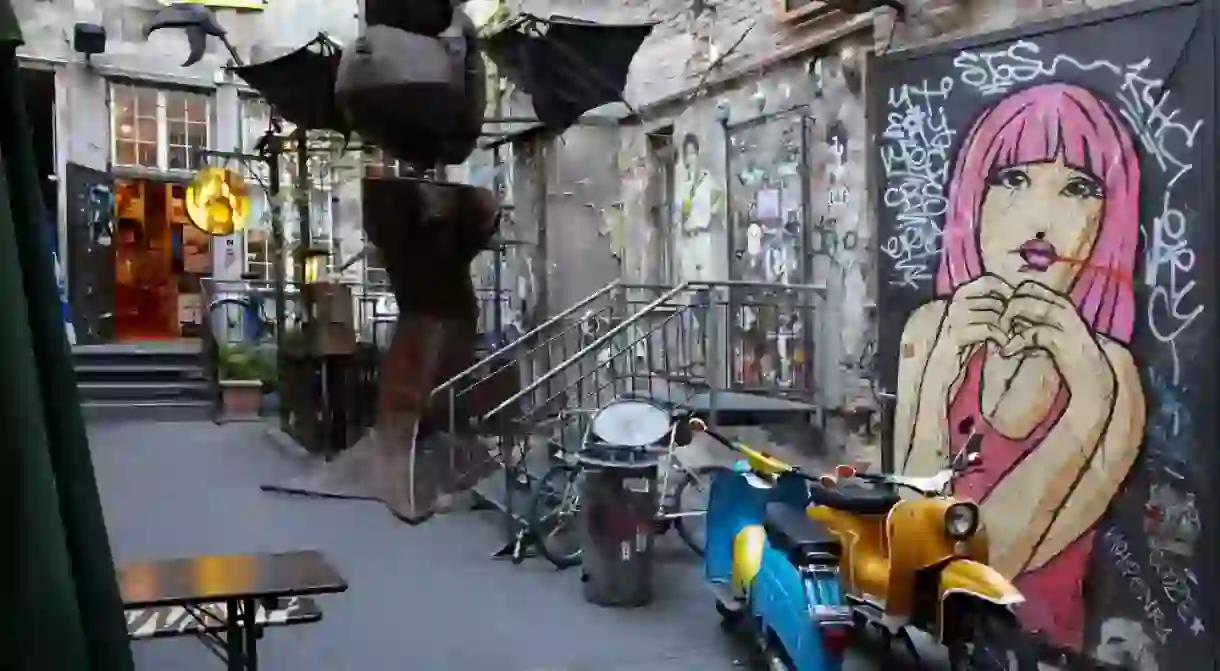11 Photos That Prove Berlin Is An Artist's Playground

The gritty chic of Berlin has been calling to artists since the fall of the Wall. The city’s Bohemian allure, history and affordable rents have helped created a mecca for artists and creatives who now call the city home. Awash in culture and unique perspectives, there is plenty in Berlin to keep artists inspired, and studies show that it remains a beloved haven for artists. Free to create and express themselves, Berlin is truly an artist’s playground, and here are 11 photos that prove why.

The dichotomy of the city’s architecture
Berlin’s history often plays into the city’s flourishing and multifaceted art scene, and little reflects the fragmented regimes and tumultuous past better than the city’s diverse architecture. Political change has produced fascinating architectural gems – neoclassical, baroque masterpieces line the city’s historic centre, while brutalism and Stalinist architecture are dotted across Berlin. This dichotomy not only reflects the city’s past, but has also inspired photographers, painters and artists of all kinds who call the city home.

Contemporary art fills Berlin’s forgotten places
Berlin’s ever-evolving, diverse and contemporary art scene has flowed over from the conventional gallery and art spaces out into the city’s forgotten bunkers, abandoned places and skeletal relics. These contemporary spaces transcend the commerciality of art and reflect the city’s unique attitude.

The urban art centre
Urban Spree is an independent art centre, grassroots gallery and event space in Berlin’s edgy Friedrichshain neighbourhood. Located in the RAW compound, the quirky, sociocultural centre for creatives in the heart of Berlin, this unique art space is dedicated to showcasing urban culture with its exhibitions, events, artist residencies and concerts.

There is art in the most unlikely of places
Improvised art still finds its place in Berlin’s urban art scene, and beyond the wall-size street murals, there is some easily missed famous art dotted all over the city’s streets. Tiny cork men, known as Korkmännchen, performing acrobatic stunts are tactfully placed across the city atop street signs. Yoga instructor Josef Foos began creating these sporty sculptures in 2011, and thousands are now scattered throughout the city.

Sundays are a busker’s paradise
Every Sunday, Mauerpark in the heart of Berlin becomes a busker’s paradise, as the park surrounding the weekly flea market fills with a range of musicals to serenade passers-by. With an eclectic mix of performers, ranging from rock bands to reggae or soulful soloists, the park holds an electric atmosphere, and many local artists have created local cult followings here. Meanwhile, at the park’s amphitheatre, brave locals and tourists join in the fun by singing at the city’s favourite karaoke sessions, known as Bearpit Karaoke.

Abandoned spaces to explore and inspire
The turbulent history of Berlin has left the city scattered with abandoned spaces. From forgotten amusement parks to abandoned swimming pools and left-behind spy stations, the city is rich with hauntingly beautiful spaces that act as windows into Berlin’s past. These unique spaces ignite the curiosity and have inspired artists, photographers and urban explorers all over Berlin.

A metropolis of galleries
Art lovers and creators will find their creative compass on a perpetual spin in Berlin; home to over 400 galleries, an impressive selection of world-class collections and plenty of independent shows, it has cemented itself as a cultural hub. While there are galleries dotted across the city, the most notable is Museum Island, a unique collection of galleries and museums on a Spree Island in Berlin’s centre, Mitte. A UNESCO World Heritage Site, it is a cultural and architectural testament and considered Berlin’s own Acropolis of the arts.

Using the city as a canvas
In a city where freedom, expression and edgy culture prevail, it is no surprise that artists choose to use the city’s streets and buildings as their canvas. Iconic tags, politically charged murals and colourful splatters are painted throughout the city, and graffiti remains an important artistic expression ever since the Wall fell.

Streets are filled with history and inspiration
From the Roaring ’20s to the debauchery of the late ’70s and early ’80s, Berlin has always been a haven for the weird and wonderful artists throughout history. A walk through Berlin’s former West lets creatives explore the house where Bowie would lay his head in between partying and writing the Berlin trilogy, or a catching a night of live music in Kreuzberg can put artists in the spot where Iggy Pop would perform impromptu concerts. The city is filled with artistic energy and history for creatives to draw inspiration from.

Great design can be found around the city
Amazing design can be found all over Berlin’s gritty yet glamorous city, earning it the title as a UNESCO City of Design. Designers and design lovers don’t have to look far for inspiration here, from the city’s quirky museums to its architecture and even its underground club posters, great design is a core part of Berlin.

You can rub shoulders with artists from all over the world
Since the fall of the Berlin Wall, tens of thousands of artists have flocked to Berlin, creating a network of international, multicultural and diverse artists. A haven for emerging and international artists, the experimental spirit and undercurrent of tolerance means artists in Berlin can rub shoulders with, collaborate and be inspired by other creatives from all over the world.













